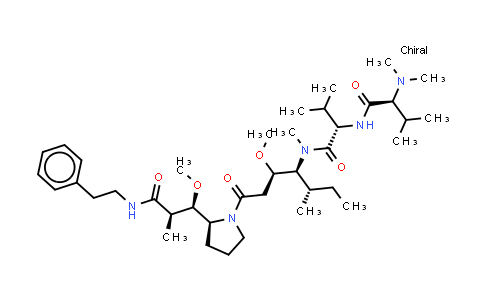| Chemical Name |
Soblidotin |
| CAS Number |
149606-27-9 |
| MDL Number |
MFCD09838692 |
| Molecular Formula |
C39H67N5O6 |
| Molecular Weight |
701.98 |
| Synonyms |
Auristatin PE;TZT-1027 |
Introduction of 149606-27-9 :
Soblidotin (Auristatin PE) is a novel synthetic Dolastatin 10 derivative and inhibitor of tubulin polymerization. IC50 & Target: Tubulin[1] In Vitro: Soblidotin (Auristatin PE) is a novel synthetic dolastatin 10 derivative that inhibits tubulin polymerization. Soblidotin (Auristatin PE) exhibits antitumor activity against p-glycoprotein-overexpressing cell lines established from colon cancer H116 and breast cancer-resistant protein-positive cell lines established from lung cancer PC-6, and is more potent than Vincristine, Paclitaxel, and Docetaxel against these cell lines[1]. Soblidotin (Auristatin PE) is a synthetic analog of dolastatin 10 which inhibits the growth of several tumoral cell lines and induces caspase-3-dependent apoptosis. Soblidotin (Auristatin PE) also shows antitumoral activity in Vincristine-, Docetaxel-, and Paclitaxel-resistant tumors, which makes it a potential chemotherapy drug for use in tumors which do not respond to other microtubule inhibitors[2]. In Vivo: Intravenous injection of Auristatin PE (TZT-1027) has been shown to potently inhibit the growth of P388 leukemic cells and several solid tumors in mice, and to prolong the survival of the animals, and its antitumor efficacy has been shown to be superior or comparable to that of the reference agents Dolastatin 10, Cisplatin, Vincristine, and 5-Fluorouracil. Furthermore, in xenograft models, Auristatin PE reduces intratumoral blood perfusion 1 to >24 h after its administration, thereby producing hemorrhagic necrosis of the tumors[1]. Auristatin PE (Soblidotin) shows antivascular effects in tumoral models overexpressing VEGF and in murine colon tumors, with an increase in vascular permeability, vessel closure, and widespread hemorrhage[2]. Mice bearing subcutaneous HT-29 tumors (200 mm3) are dosed every 7 days with Auristatin PE (0.5 or 1.0 mg/kg) for a total of four cycles. Under such conditions, Auristatin PE (TZT-1027) inhibits the growth of HT-29 xenografts in a dose-dependent manner. Coadministration of Auristatin PE does not interfere with the PD184352-induced suppression of ERK1/2 phosphorylation. Immunostaining for Ki-67 as a marker for proliferating cells confirmed that the number of such cells in tumor sections is decreased greatly at 24 hours after the initial dosing with PD184352 compared with that apparent for vehicle-treated tumors. Auristatin PE treatment alone increases the number of TUNEL-positive cells in HT-29 xenografts by 24 hours in a dose-dependent manner, and this effect is enhanced by coadministration of PD184352[3].
| Purity |
NLT 98% |
| Storage |
at 20ºC 2 years |
*The above information is for reference only.
